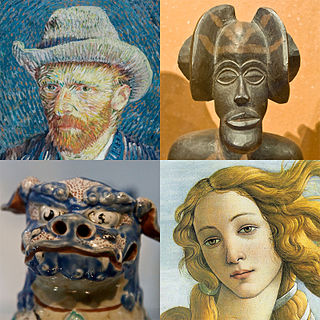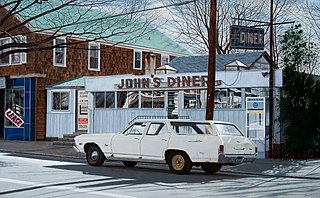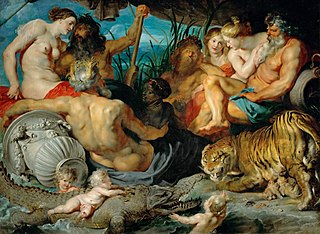
Art is a diverse range of human activity, and resulting product, that involves creative or imaginative talent expressive of technical proficiency, beauty, emotional power, or conceptual ideas.

Aesthetics is a branch of philosophy that deals with the nature of beauty and taste, as well as the philosophy of art. It examines aesthetic values, often expressed through judgments of taste.
Conceptual art, also referred to as conceptualism, is art in which the concept(s) or idea(s) involved in the work take precedence over traditional aesthetic, technical, and material concerns. Some works of conceptual art, sometimes called installations, may be constructed by anyone simply by following a set of written instructions. This method was fundamental to American artist Sol LeWitt's definition of conceptual art, one of the first to appear in print:
In conceptual art the idea or concept is the most important aspect of the work. When an artist uses a conceptual form of art, it means that all of the planning and decisions are made beforehand and the execution is a perfunctory affair. The idea becomes a machine that makes the art.

Photorealism is a genre of art that encompasses painting, drawing and other graphic media, in which an artist studies a photograph and then attempts to reproduce the image as realistically as possible in another medium. Although the term can be used broadly to describe artworks in many different media, it is also used to refer specifically to a group of paintings and painters of the American art movement that began in the late 1960s and early 1970s.
The Cyprus College of Art (CyCA) is an artists' studio group, located in the village of Lempa on the west coast of Cyprus. It was founded in 1969 by the artist Stass Paraskos; the current director is the Cyprus-based artist Margaret Paraskos.

Stass Paraskos was an artist from Cyprus, although much of his life was spent teaching and working in England.
In art history, formalism is the study of art by analyzing and comparing form and style. Its discussion also includes the way objects are made and their purely visual or material aspects. In painting, formalism emphasizes compositional elements such as color, line, shape, texture, and other perceptual aspects rather than content, meaning, or the historical and social context. At its extreme, formalism in art history posits that everything necessary to comprehending a work of art is contained within the work of art. The context of the work, including the reason for its creation, the historical background, and the life of the artist, that is, its conceptual aspect is considered to be external to the artistic medium itself, and therefore of secondary importance.

Anarchism has long had an association with the arts, particularly with visual art, music and literature. This can be dated back to the start of anarchism as a named political concept, and the writings of Pierre-Joseph Proudhon on the French realist painter Gustave Courbet. In an essay on Courbet of 1857 Proudhon had set out a principle for art, which he saw in the work of Courbet, that it should show the real lives of the working classes and the injustices working people face at the hands of the bourgeoisie.

A work of art, artwork, art piece, piece of art or art object is an artistic creation of aesthetic value. Except for "work of art", which may be used of any work regarded as art in its widest sense, including works from literature and music, these terms apply principally to tangible, physical forms of visual art:
The Leeds Arts Club was founded in 1903 by the Leeds primary school teacher Alfred Orage and Holbrook Jackson, a lace merchant and freelance journalist, and was one of the most advanced centres for modernist thinking, radical thought and experimental art in Britain in the pre-First World War period.

Art historians and philosophers of art have long had classificatory disputes about art regarding whether a particular cultural form or piece of work should be classified as art. Disputes about what does and does not count as art continue to occur today.

Irsee is a village and municipality in the district of Ostallgäu in Bavaria in Germany.
Michael Paraskos, FHEA, FRSA is a novelist, lecturer and writer on art. He has written several non-fiction and fiction books and essays, and articles on art, literature, culture and politics for various publications, including Art Review, The Epoch Times, The Guardian newspaper and The Spectator magazine. In the past he has reviewed art exhibitions for BBC radio, curated exhibitions, and taught in universities and colleges in Britain and elsewhere. He has a particular focus on modern art, having published books on the art theorist Herbert Read, and he is also known for his theories connecting anarchism and modern art. He lives in West Norwood in south London.
Clive Head is a painter from Britain.
The Prague Project was an art project involving the photorealist painters Anthony Brunelli, Clive Head, Bertrand Meniel and Raphaella Spence, and the writer Michael Paraskos, held in Prague in 2003. It culminated in an exhibition at the Roberson Museum and Science Center, Binghamton, New York in 2004-2005, and an accompanying catalogue.
A theory of art is intended to contrast with a definition of art. Traditionally, definitions are composed of necessary and sufficient conditions and a single counterexample overthrows such a definition. Theorizing about art, on the other hand, is analogous to a theory of a natural phenomenon like gravity. In fact, the intent behind a theory of art is to treat art as a natural phenomenon that should be investigated like any other. The question of whether one can speak of a theory of art without employing a concept of art is also discussed below.
Post-conceptual, postconceptual, post-conceptualism or postconceptualism is an art theory that builds upon the legacy of conceptual art in contemporary art, where the concept(s) or idea(s) involved in the work takes some precedence over traditional aesthetic and material concerns. The term first came into art school parlance through the influence of John Baldessari at the California Institute of the Arts in the early 1970s. The writer Eldritch Priest, specifically ties John Baldessari's piece Throwing four balls in the air to get a square from 1973 as an early example of post-conceptual art. It is now often connected to generative art and digital art production.
Jennifer Durrant is a British artist.
Mali Morris is a British artist. She was born in north Wales, and studied at Newcastle University and the University of Reading.

Ontopoetics is a philosophical concept that involves the communicative engagement of self with the world and the world with the self. It is also described as a "poetic order" that unfolds alongside the "causal order" in the process of the communicative engagement with reality and participating in it. It includes the perception of cues or signals, or the expression of actors, as well as "the construction of impressions on re-actors by the deliberate choice of attractive signifiers that communicate factual or illusory realities".








